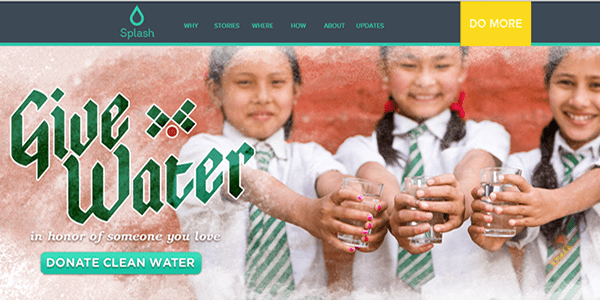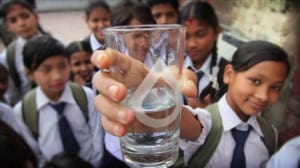
Our Senior Marketing Manager, Jill Boyer, sat down with Peter Drury, Director of Strategy with Splash in Seattle, WA to talk marketing, nonprofit branding, and peer-to-peer fundraising.
Peter and Jill discussed how Splash’s marketing strategies have aided its fundraising, and more specifically, what prompted the organization’s re-brand. Seven years old, Splash’s original name was “A Child’s Right”. Its mission is to provide children with clean drinking water. However, the organization experienced problems with that name because it didn’t say anything about water and it gave way to misconceptions about the purpose of the mission.  The organization was founded on a social justice imperative; that every child has a right to clean drinking water. Peter noted that for nonprofit branding, it’s important to put on a marketing hat. In Splash’s case, its Founder and Director, Eric Stowe, is not a marketer, he is a fundraiser, but when the organization put on its marketing hat in 2012 and revamped its brand, it experienced a boom.
The organization was founded on a social justice imperative; that every child has a right to clean drinking water. Peter noted that for nonprofit branding, it’s important to put on a marketing hat. In Splash’s case, its Founder and Director, Eric Stowe, is not a marketer, he is a fundraiser, but when the organization put on its marketing hat in 2012 and revamped its brand, it experienced a boom.
With the original name, the organization found many times that people backed up in conversation, not only to clarify what the organization did, but sometimes to see if the organization was in the abortion debate or international children’s rights; “there was too much room for interpretation with the original name” said Peter. Out of the gate, the name of the organization was a problem because it was grammatically and political challenging. Peter commented that a solid marketing strategy is about cultivating a relationship and invites someone to listen, but this name proved to be a barrier to that relationship.
 This then led the organization to a name change and sub-sequentially a brand change. They changed their name to Splash, which conjures up the idea of water and translates well in other languages. “A splash is a physical activity that happens in every country and translates well” said Peter. They also decided to simplify the logo. They then created a Creative Brief to decide what they aimed to accomplish with the word Splash, which Peter believes is to suspend judgement. Simply put, the organization cleans water and Peter argues that Splash allows, from a marketing perspective, listeners to suspend their judgement about something they already believe to be true, which is that once water is dirty, it stays dirty. Splash’s sole purpose is to clean this dirty water to make it drinkable. From the name, and based on this notion, the organization went on to establish its mission tag-line: “clean water for kids”, which is a nice and elegant way to describe Splash’s mission. Simultaneously, they sought to identify their target audience; people who are interested in clean water and have the capacity to help.
This then led the organization to a name change and sub-sequentially a brand change. They changed their name to Splash, which conjures up the idea of water and translates well in other languages. “A splash is a physical activity that happens in every country and translates well” said Peter. They also decided to simplify the logo. They then created a Creative Brief to decide what they aimed to accomplish with the word Splash, which Peter believes is to suspend judgement. Simply put, the organization cleans water and Peter argues that Splash allows, from a marketing perspective, listeners to suspend their judgement about something they already believe to be true, which is that once water is dirty, it stays dirty. Splash’s sole purpose is to clean this dirty water to make it drinkable. From the name, and based on this notion, the organization went on to establish its mission tag-line: “clean water for kids”, which is a nice and elegant way to describe Splash’s mission. Simultaneously, they sought to identify their target audience; people who are interested in clean water and have the capacity to help.
Since the re-brand, Splash has experienced a huge jump in fundraising. In 2010, its annual budget was around $750K, in 2012 it was $1.8M, and today, in 2014, it is $3.4M and growing! They currently have 65 staff internationally. Within 16 months they are going to announce that every orphanage in China has safe drinking water, which they pulled this off in about 6.5 years. In Nepal by 2020 they will have achieved the same success. They are scaling ambitiously and they look at fundraising in a way they didn’t use to, and as such they have restructured their strategy towards deep institutional relationships that are major gifts driven. Peter very much attributes their success to their re-brand because the word Splash was so good, the visuals were so well executed, and they took the ‘simple is more’ approach, which paid off. People understood them immediately.
With their new website in tow, they are now moving into attracting new donors online, which was not something they participated much in earlier. Powered by major gifts, Splash’s second biggest area of focus is social media and thirdly peer-to-peer fundraising. Peter specified that after getting their new brand out there, the organization hopes to focus more on tying its social media to fundraising goals. So now, two years after the re-brand, their team feels comfortable to launch  their peer-to-peer fundraising online!
their peer-to-peer fundraising online!
Peter’s biggest piece of advice to fellow organizations was to focus on and retain the donors you already have, as opposed to going out and finding new ones. Donor retention should be your number one goal because the cost of on-boarding new donors is far more than retention of your current pool. Splash’s strategy for donor retention is: gratitude (thank-you’s), hospitality (degree to which they welcome people into Splash), integrity (transparency), and community (bring people together to reinforce one another).
On a personal note, Splash’s website is one of our absolute favorite sites!
